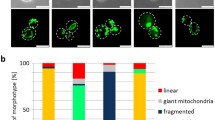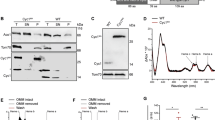Abstract
It was shown that separate fragments of the inner mitochondrial compartment (mitoplasts) can exist under a single non-fragmented outer membrane. Here we asked whether fragmentation of the inner mitochondria could prevent rupturing of the outer membrane and release of pro-apoptotic molecules from the mitochondrial intermembrane space into the cytoplasm during mitochondrial swelling. First, we showed that in Saccharomyces cerevisiae yeast addition of amiodarone causes formation of electrically separate compartments within mitochondrial filaments. Moreover, amiodarone treatment of Δysp2 mutant produced a higher proportion of cells with electrically discontinuous mitochondria than in the wild type, which correlated with the survival of cells. We confirmed the existence of separated mitoplasts under a single outer membrane using electron microscopy. Mitochondria with fragmented matrixes were also detected in cells of the stationary phase. Our data suggest that such fragmentation acts as a cellular protective mechanism against stress.
Similar content being viewed by others
Abbreviations
- FCCP:
-
carbonyl cyanide p-(trifluoromethoxy)phenylhydrazone
- GFP:
-
green fluorescent protein
- TMR:
-
tetramethyl rhodamine
References
Amchenkova, A. A., Bakeeva, L. E., Chentsov, Y. S., Skulachev, V. P., and Zorov, D. B. (1988) J. Cell Biol., 107, 481–495.
Skulachev, V. P., Bakeeva, L. E., Chernyak, B. V., Domnina, L. V., Minin, A. A., Pletjushkina, O. Y., Saprunova, V. B., Skulachev, I. V., Tsyplenkova, V. G., Vasiliev, J. M., Yaguzhinsky, L. S., and Zorov, D. B. (2004) Mol. Cell Biochem., 256/257, 341–358.
Madeo, F., Herker, E., Wissing, S., Jungwirth, H., Eisenberg, T., and Frohlich, K. U. (2004) Curr. Opin. Microbiol., 7, 655–660.
Gordeeva, A. V., Labas, Y. A., and Zvyagilskaya, R. A. (2004) Biochemistry (Moscow), 69, 1055–1066.
Kaasik, A., Safiulina, D., Zharkovsky, A., and Veksler, V. (2007) Am. J. Physiol. Cell Physiol., 292, C157–C163.
Skulachev, V. P. (2002) Ann. N. Y. Acad. Sci., 959, 214–237.
Sherman, F. (2002) Meth. Enzymol., 350, 3–41.
Tolic-Norrelykke, I. M., Sacconi, L., Stringari, C., Raabe, I., and Pavone, F. S. (2005) Curr. Biol., 15, 1212–1216.
Yang, H., Ren, Q., and Zhang, Z. (2006) FEMS Yeast Res., 6, 1254–1263.
Westermann, B., and Neupert, W. (2000) Yeast, 16, 1421–1427.
Pozniakovsky, A. I., Knorre, D. A., Markova, O. V., Hyman, A. A., Skulachev, V. P., and Severin, F. F. (2005) J. Cell Biol., 168, 257–269.
Sokolov, S., Knorre, D., Smirnova, E., Markova, O., Pozniakovsky, A., Skulachev, V., and Severin, F. (2006) Biochim. Biophys. Acta, 1757, 1366–1370.
Lewandowska, A., Gierszewska, M., Marszalek, J., and Liberek, K. (2006) Biochim. Biophys. Acta, 1763, 141–151.
Vieira, H. L., Boya, P., Cohen, I., El Hamel, C., Haouzi, D., Druillenec, S., Belzacq, A. S., Brenner, C., Roques, B., and Kroemer, G. (2002) Oncogene, 21, 1963–1977.
Breckenridge, D. G., Germain, M., Mathai, J. P., Nguyen, M., and Shore, G. C. (2003) Oncogene, 22, 8608–8618.
Fannjiang, Y., Cheng, W. C., Lee, S. J., Qi, B., Pevsner, J., McCaffery, J. M., Hill, R. B., Basanez, G., and Hardwick, J. M. (2004) Genes Dev., 18, 2785–2797.
Frank, S., Gaume, B., Bergmann-Leitner, E. S., Leitner, W. W., Robert, E. G., Catez, F., Smith, C. L., and Youle, R. J. (2001) Dev. Cell, 1, 515–525.
Scheckhuber, C. Q., Erjavec, N., Tinazli, A., Hamann, A., Nystrom, T., and Osiewacz, H. D. (2007) Nat. Cell Biol., 9, 99–105.
Sun, M. G., Williams, J., Munoz-Pinedo, C., Perkins, G. A., Brown, J. M., Ellisman, M. H., Green, D. R., and Frey, T. G. (2007) Nat. Cell Biol., 9, 1057–1072.
Author information
Authors and Affiliations
Corresponding author
Additional information
Published in Russian in Biokhimiya, 2008, Vol. 73, No. 11, pp. 1561–1568.
Originally published in Biochemistry (Moscow) On-Line Papers in Press, as Manuscript BM08-057, October 12, 2008.
Electronic supplementary material
Rights and permissions
About this article
Cite this article
Knorre, D.A., Ojovan, S.M., Saprunova, V.B. et al. Mitochondrial matrix fragmentation as a protection mechanism of yeast Saccharomyces cerevisiae . Biochemistry Moscow 73, 1254–1259 (2008). https://doi.org/10.1134/S0006297908110126
Received:
Revised:
Published:
Issue Date:
DOI: https://doi.org/10.1134/S0006297908110126




